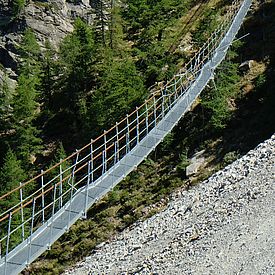In a literature review for the adaptation to climate change project "Safe Hiking 2040", researchers from the WSL Institute for Snow and Avalanche Research (SLF) analysed how changes in alpine hazards could affect hikers and hiking trails in the future. The results will now serve as a basis for case studies in various pilot regions and are intended to help develop adaptation measures.
Hiking is popular in Switzerland and could become even more so in the future: not only is global warming extending the hiking season in the mountains but heat waves in lowland areas are leading more and more people to seek cooler mountain climes. At the same time, the risks involved in hiking are liable to change: according to climate change scenarios, extreme weather events such as heavy rain or drought are set to increase, which will have an impact on natural hazards in the mountains.
SLF researchers have now examined the implications of this for hikers and hiking trails as part of the "Safe Hiking 2040" project (in German) initiated by the Schwyz cantonal hiking trail association Schwyzer Wanderwege and its umbrella organisation, the Swiss Hiking Trail Association. They did this by analysing the scientific literature and compiling the key findings to produce a synthesis (in German). Expert workshops were also held. "The aim was to identify relevant natural hazards and create a knowledge base for practical measures," explains SLF researcher Alexander Bast.
Increasing rockfall and debris flows
Gravitational processes in particular, such as rockfall or rock slope failures, are likely to become more common and more extreme. This will especially affect alpine and high-alpine terrain, including high-altitude mountain and alpine hiking trails. "Gravitational processes occur suddenly, which makes them very difficult to predict," says Bast. Hikers can reduce the risk by really doing their homework and planning their route carefully, for example avoiding very exposed rock faces after heavy rainfall or major temperature fluctuations. However, more frequent damage to hiking trails is inevitable, making them more expensive to maintain.
Hiking is also affected by other natural hazards, such as debris flows, landslides and summer avalanches. These will be impacted in different ways depending on the region, altitude and season. For instance, debris flows could decrease in summer due to drought but become more frequent in spring and autumn because of heavy precipitation. However, the review's authors consider it unlikely that climate change will result in any completely new hazard sources, alongside those already known about.
Effects already being felt
Climate change is already having an impact on hiking, for example around the Aletsch Glacier, whose retreat has destabilised rock faces and slopes, forcing the closure of hiking trails or the creation of new ones. A trail also had to be closed temporarily on the Flüela Wisshorn in Grisons, following a rock slope failure in 2019.
The results of the literature review will now serve as the basis for the next project phase, which will see case studies undertaken in three pilot regions in the cantons of Schwyz, Valais and Grisons, to apply the findings to regional circumstances. This will yield a compendium of information which those responsible for hiking trails can use to tackle future challenges in a proactive, targeted way.
The Safe Hiking 2040 project is part of the Federal Office for the Environment's pilot programme Adaptation to climate change. Aimed at preparing hiking trails for the new challenges posed by climate change, the project was initiated by the Schwyz cantonal hiking trail association Schwyzer Wanderwege and its umbrella organisation, the Swiss Hiking Trail Association. Other project participants are Zurich University of Applied Sciences (ZHAW), the WSL Institute for Snow and Avalanche Research (SLF), the Federal Roads Office, the Canton of Grisons and the Canton of Valais.
Contact
Copyright
WSL and SLF provide the artwork for imaging of press articles relating to this media release for free. Transferring and saving the images in image databases and saving of images by third parties is not allowed.

